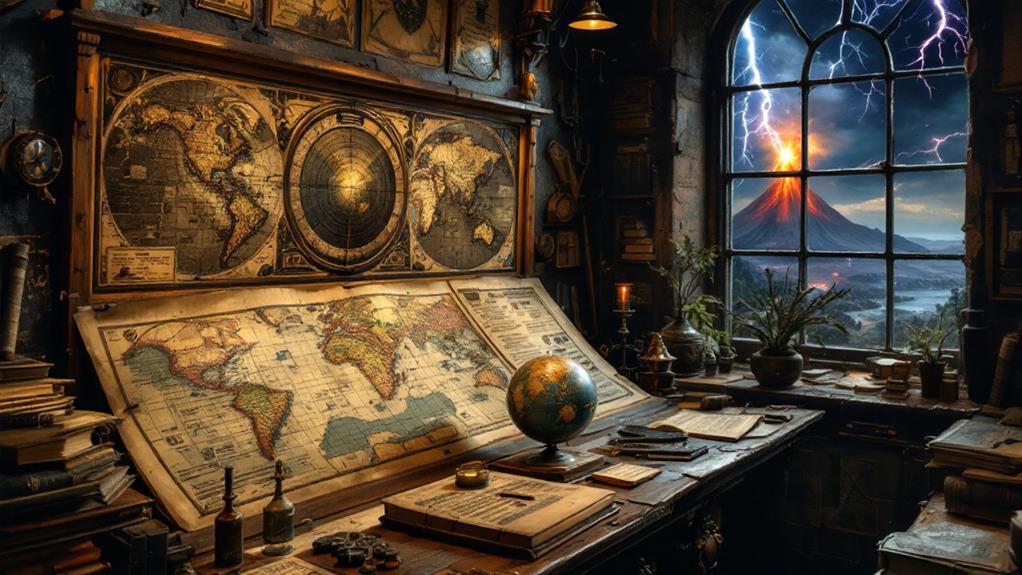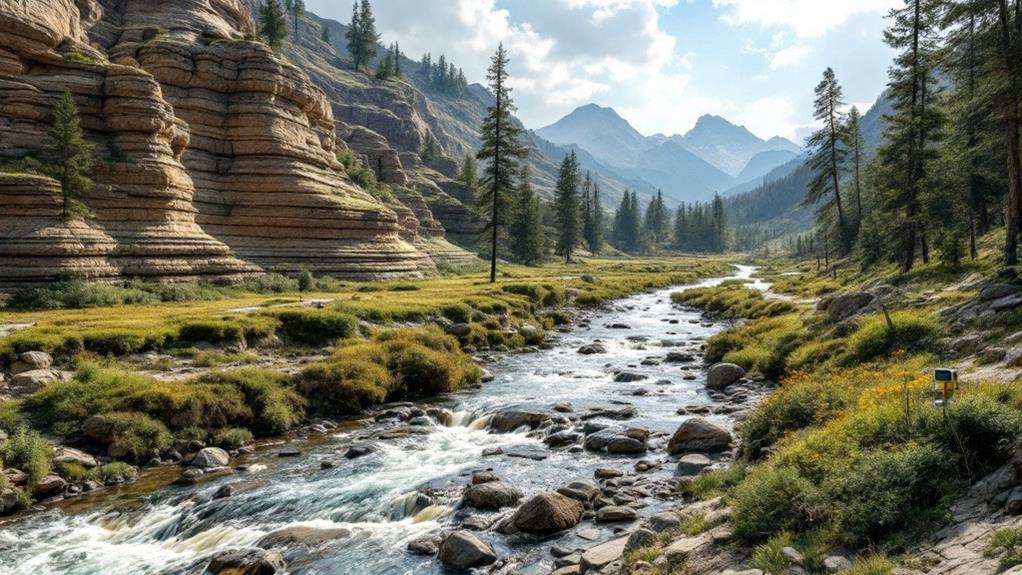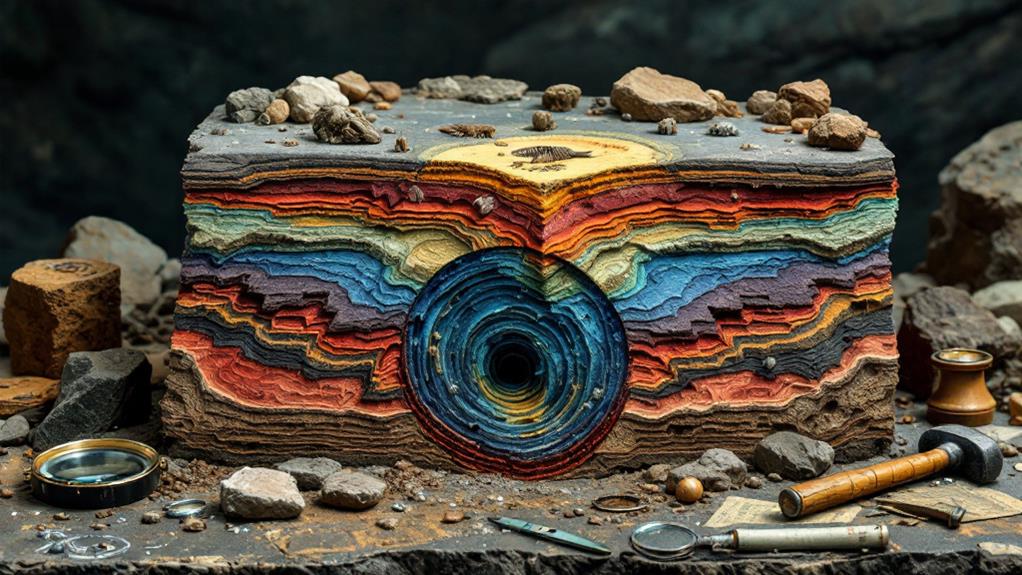A Complete Guide to Earth Science: Understanding Our Planet
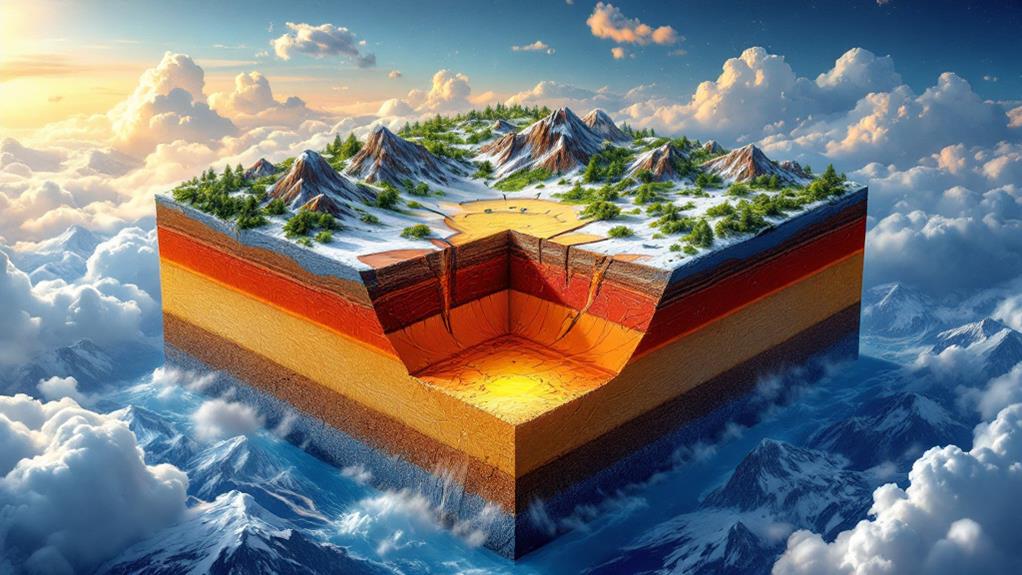
Earth science plunges into our planet's complex systems, from its layered structure to the energetic forces shaping its surface. You'll uncover how plate tectonics drive continental drift and create geological features. Learn about the diverse rocks and minerals that form Earth's crust, and how the water cycle sustains life. Understand atmospheric processes influencing weather and climate, and submerge into the expansive oceans teeming with marine ecosystems. Excavate Earth's fascinating geological history and prepare for natural hazards. You'll also gain perception into our planet's position in space. This expedition through Earth science will reveal the interconnected wonders of our world.
The Earth's Structure
The Earth's structure consists of four main layers. As you probe deeper into our planet's composition, you'll uncover a fascinating arrangement that shapes Earth's internal dynamics. The outermost layer, the crust, is where we live. It's relatively thin, varying from about 5 to 70 kilometers thick. Beneath the crust lies the mantle, the thickest layer, extending about 2,900 kilometers deep. It's mostly solid but can flow slowly over time, driving plate tectonics.
Next, you'll find the outer core, a layer of liquid iron and nickel that generates Earth's magnetic field. It's about 2,200 kilometers thick. At the planet's center is the inner core, a solid ball of iron and nickel with a radius of about 1,220 kilometers. The intense pressure at this depth keeps it solid despite extremely high temperatures.
Understanding Earth's structure is pivotal for grasping various geological processes. The interactions between these layers drive volcanic activity, earthquakes, and the formation of mountains. They also play a vital role in the planet's heat distribution and magnetic field generation.
Plate Tectonics and Continental Drift
Beneath the Earth's crust, powerful forces are at work, propelling the theory of plate tectonics. This concept explains how Earth's lithosphere is divided into large, rigid plates that move and interact with one another. You'll find that these plates float on the semi-fluid asthenosphere, constantly shifting and reshaping the Earth's surface.
Continental drift, first proposed by Alfred Wegener in 1912, forms the foundation of plate tectonics. It suggests that continents were once joined in a supercontinent called Pangaea before breaking apart and relocating to their current positions. Evidence for this includes matching coastlines, similar fossil records, and corresponding rock formations across different continents.
Plate interactions are responsible for various geological phenomena. When plates collide, they can form mountain ranges or trigger volcanic activity. Diverging plates create rifts and new oceanic crust. Transform boundaries, where plates slide past each other, often result in earthquakes. Understanding these processes is pivotal for volcano formation studies and earthquake prediction efforts. By analyzing plate movements and stress patterns, scientists can better assess potential hazards and improve early warning systems for geological events.
Rocks and Minerals
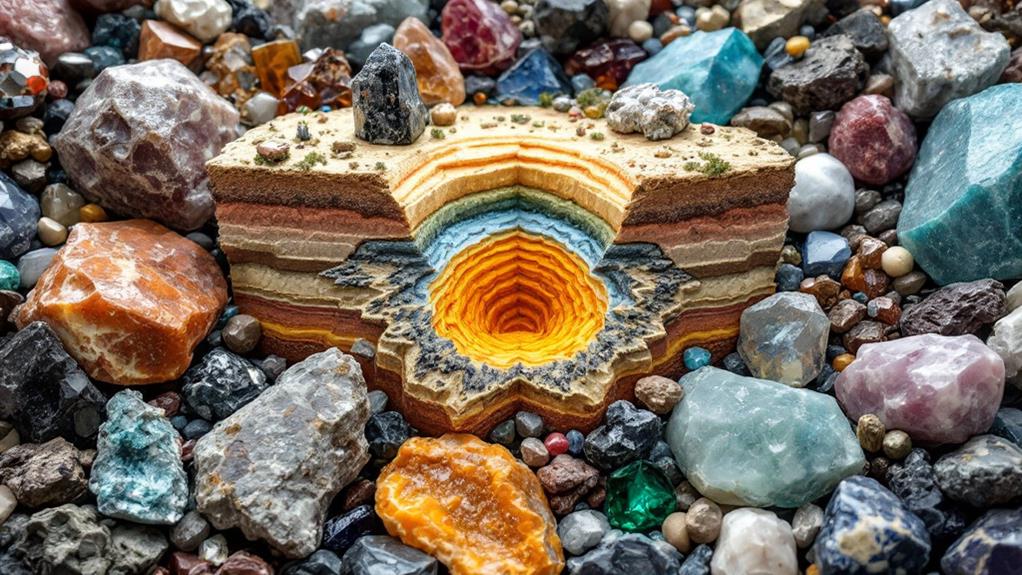
Three fundamental components form the building blocks of Earth's crust: rocks, minerals, and crystals. You'll find these elements everywhere, from mountain ranges to sandy beaches. Rocks are solid masses composed of one or more minerals, while minerals are naturally occurring inorganic substances with specific chemical compositions and crystal structures.
Understanding crystal formation is indispensable in Earth science. Crystals form when atoms arrange themselves in repeating patterns as minerals solidify. You'll often see them in geodes or as gemstones. Mineral identification is a key skill for geologists, involving various tests and observations.
To deepen your understanding of rocks and minerals:
- Study their physical properties: color, luster, hardness, and cleavage
- Learn about the rock cycle: igneous, sedimentary, and metamorphic rocks
- Investigate how minerals contribute to soil formation and plant growth
You'll encounter three main rock types: igneous (formed from cooled magma), sedimentary (created by the deposition of sediments), and metamorphic (transformed by heat and pressure). By examining these rocks and their mineral compositions, you can uncover Earth's geological history and better comprehend the processes shaping our planet's surface.
The Water Cycle
From the depths of the ocean to the heights of the atmosphere, water's continuous trek sculpts our planet's climate and terrain. This excursion, known as the water cycle, is a complex process that you can observe in your daily life. It begins with evaporation, where the sun's heat turns liquid water into vapor. This vapor rises into the atmosphere, forming clouds through condensation.
As clouds move, they release water back to Earth as precipitation in various forms like rain, snow, or hail. These precipitation patterns vary across the globe, shaping diverse ecosystems and environments. When water reaches the ground, it either flows into bodies of water or seeps into the soil, replenishing groundwater resources.
Plants play a crucial role in the cycle through transpiration, releasing water vapor from their leaves. This process, combined with evaporation from soil and water surfaces, is called evapotranspiration. The cycle then repeats, constantly redistributing water across the planet.
Understanding the water cycle is essential for managing water resources, predicting weather patterns, and addressing climate change impacts on our environment.
Atmospheric Processes and Climate
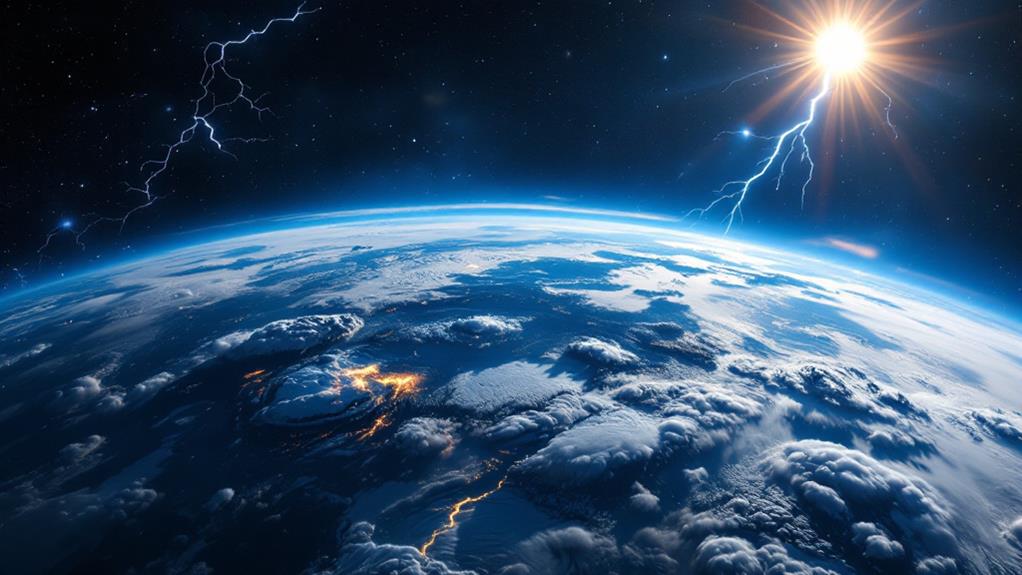
The Earth's atmosphere is a fluid system that drives our planet's weather and climate. It's a complex interplay of gases, energy, and moisture that creates the conditions we experience daily. You'll find that atmospheric processes are responsible for everything from gentle breezes to severe storms, and they play a pivotal role in shaping our climate over time.
Climate, the long-term average of weather patterns, is influenced by various factors, including:
- Solar radiation and its distribution across the globe
- Ocean currents and their heat transfer capabilities
- The composition of the atmosphere, particularly greenhouse gases
Greenhouse gas emissions have become a major concern in recent years, as they're causing the Earth's average temperature to rise. This global warming trend is leading to more frequent extreme weather events and shifting climate zones. You'll also notice localized effects like urban heat islands, where cities experience higher temperatures than surrounding rural areas due to heat-absorbing surfaces and human activities.
Understanding these atmospheric processes and dynamic climate is paramount for predicting weather patterns, managing resources, and developing strategies to mitigate the impacts of climate change on our planet.
Oceans and Marine Ecosystems
Covering over 70% of Earth's surface, oceans play a key role in regulating our planet's climate and supporting diverse ecosystems. They absorb and distribute heat, influencing weather patterns and global temperatures. You'll find that oceans are divided into distinct zones based on depth, light penetration, and pressure, each hosting unique marine life.
The ocean floor is a complex landscape of underwater mountains, trenches, and plains. It's here that hydrothermal vents support bizarre ecosystems independent of sunlight. Closer to the surface, you'll encounter rich marine biodiversity in coral reefs, kelp forests, and open waters. These habitats are home to countless species, from microscopic plankton to massive whales.
Coastal ecosystems, like mangroves and salt marshes, act as crucial buffers between land and sea. They protect shorelines, filter pollutants, and serve as nurseries for many marine species. However, human activities, such as overfishing, pollution, and climate change, threaten these delicate marine environments. Understanding and preserving our oceans is essential for maintaining Earth's ecological balance and ensuring the survival of countless species, including our own.
Earth's Geological History
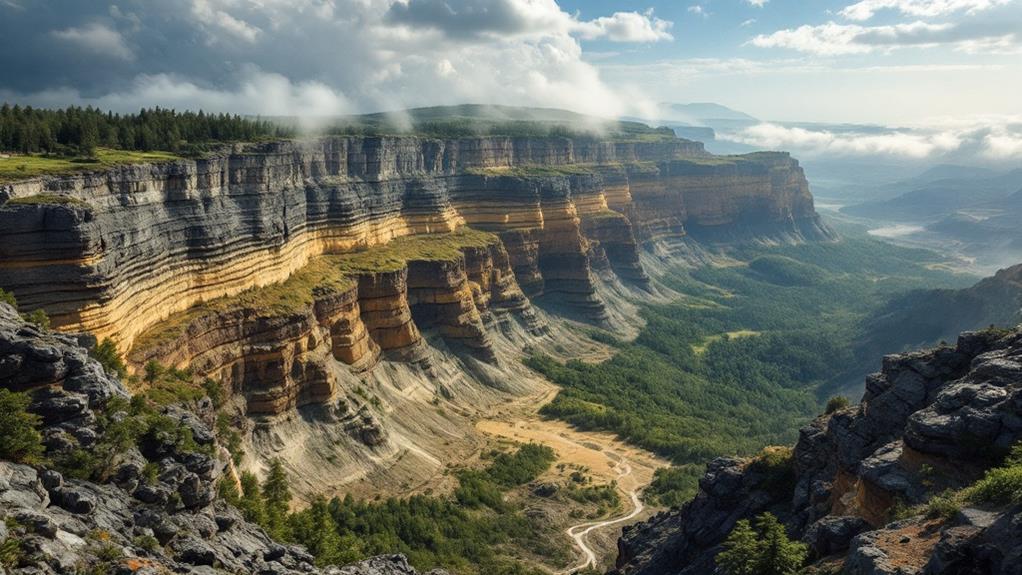
Since its formation roughly 4.6 billion years ago, Earth has undergone dramatic changes. You can observe evidence of these changes in rock layers, fossils, and landforms. Earth's geological history is divided into eons, eras, periods, and epochs, each marked by significant events and alterations.
Volcanic eruptions and glacial processes have played essential roles in shaping our planet. Volcanoes have built mountains, created islands, and released gases that influenced Earth's atmosphere. Glaciers have carved valleys, formed lakes, and transported massive amounts of sediment across continents.
To better understand Earth's geological history, consider these key points:
- Plate tectonics have driven the movement of continents and the formation of mountain ranges
- Mass extinction events have dramatically changed life on Earth multiple times
- Climate changes have caused sea levels to rise and fall, reshaping coastlines
Natural Hazards and Disasters
Natural hazards and disasters pose significant threats to human life, property, and ecosystems worldwide. You'll encounter various types of natural hazards, including geological events like earthquakes, volcanic eruptions, and landslides, as well as meteorological phenomena such as hurricanes, tornadoes, and floods. These events can cause widespread destruction and loss of life, making it indispensable to understand their causes and potential impacts.
Earthquake preparedness is essential in seismically active regions. You should develop an emergency plan, secure heavy furniture, and keep a disaster kit readily available. For volcanic eruptions, staying informed about local alert systems and evacuation routes is critical. You'll need to be aware of the risks associated with ash fall, pyroclastic flows, and lahars.
Climate change is intensifying many natural disasters, leading to more frequent and severe events. You can contribute to disaster risk reduction by supporting sustainable practices and community resilience efforts. By staying informed, preparing for potential hazards, and working collectively to address underlying vulnerabilities, you'll be better equipped to face the challenges posed by natural disasters in an ever-changing world.
Earth's Place in Space
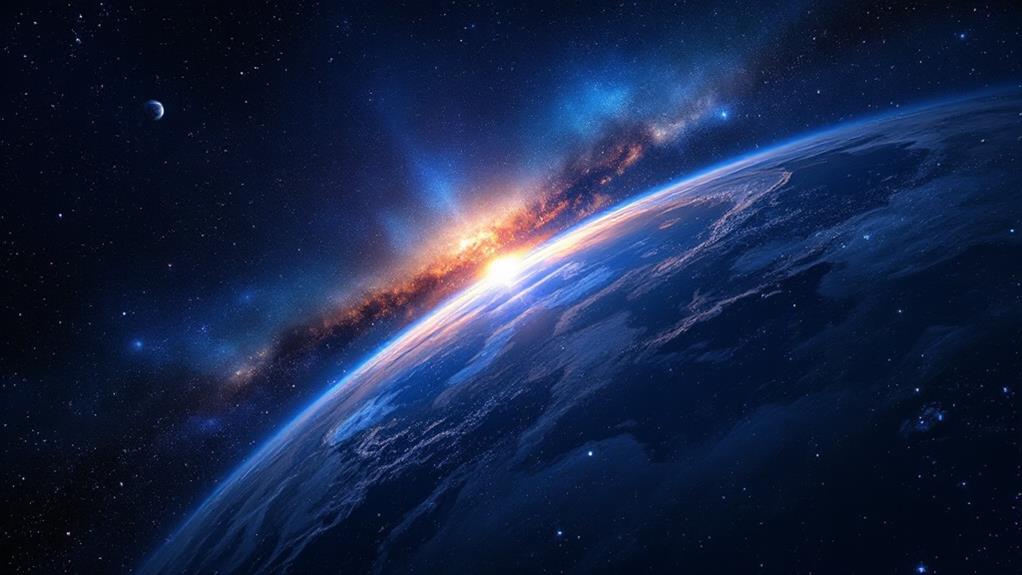
Venture beyond our planet to understand Earth's place in the vast cosmos. As you plunge into Earth's position in space, you'll uncover its unique role within our solar system. Earth is one of eight planets orbiting the Sun, nestled in the Goldilocks zone where conditions are just right for life as humanity knows it.
The solar system's composition includes a diverse array of celestial bodies, from rocky inner planets to gas giants and icy outer worlds. Earth's behavior is influenced by its interactions with these celestial neighbors, affecting everything from tides to long-term climate patterns.
To fully grasp Earth's cosmic significance, consider these points:
- Earth's position allows for a delicate balance of energy from the Sun, supporting complex life forms
- Our planet's magnetic field shields us from harmful solar radiation
- Earth's moon stabilizes our axial tilt, contributing to stable seasons
As you ponder Earth's place in space, you'll gain a deeper appreciation for the intricate celestial dance that shapes our world. Understanding these cosmic connections helps us better comprehend Earth's past, present, and potential future in the grand tapestry of the universe.
